Bulletin – December 2015 Australian Economy Consumer Sentiment Surveys
- Download the article 293KB
Abstract
There are two main consumer sentiment surveys in Australia. The headline indices that summarise the survey results appear to provide relevant and timely information about economic developments, particularly around turning points. However, in some cases, particular components of the aggregate indices are more useful. This is true of the components that track households' perceptions of their current personal finances compared with a year prior and, to a lesser extent, the components tracking households' perceptions of buying conditions for major household items.
Introduction
Accounting for a little over half of GDP, household consumption is the largest component of expenditure. It is also an important driver of business conditions and investment. As a consequence, having timely and reliable indicators for consumption is important for understanding developments in the wider economy. Consumer sentiment surveys help to fulfil this role because they provide more timely and frequent information about the state of the household sector than other indicators such as retail sales or household consumption from the national accounts.
The two main consumer sentiment surveys in Australia are provided by ANZ-Roy Morgan, and Westpac and the Melbourne Institute. This article outlines the different features of these surveys, followed by an investigation into the usefulness of the information contained in them.
Survey Features
The two main consumer sentiment surveys are very similar in scope and construction. Not surprisingly, there has always been a high degree of co-movement between the headline indices and, when divergences have occurred, they have rarely persisted (Graph 1).
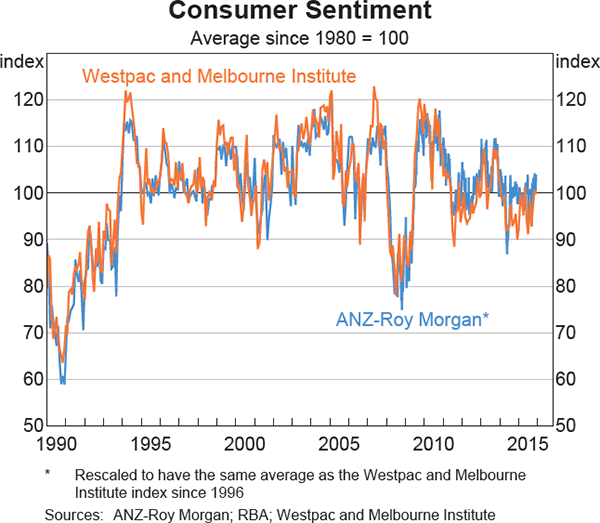
Both surveys cover a similar set of five core questions. Two questions ask survey participants to assess the state of their current personal finances compared with a year prior, and their expected state a year ahead. A further two questions ask participants for their expectations about broader economic conditions one year and five years ahead. A final question asks survey participants whether they think conditions are favourable for the purchase of major household items. Responses to each question are summarised in net balance terms, which is the percentage of positive responses less negative responses. The five net balances are then averaged across questions to generate an overall net balance – the headline consumer sentiment indices shown in Graph 1.
Despite their similarities, there are some methodological differences between the two surveys (Table 1). For instance, the ANZ-Roy Morgan survey is conducted more regularly, but the Westpac and Melbourne Institute survey has a slightly larger sample size. There are also differences in how the surveys are conducted. The ANZ-Roy Morgan survey uses a brief questionnaire administered through face-to-face interviews, whereas the sentiment questions in the Westpac and Melbourne Institute survey are one part of a longer questionnaire that is conducted over the phone.[1] The methodological differences might affect the survey responses and, indeed, the two indices have different historical means. To address the latter, the Bank standardises the two indices to have the same mean.[2]
| ANZ-Roy Morgan | Westpac and Melbourne Institute | |
|---|---|---|
| Frequency | Every Tuesday | Second Wednesday of each month(a) |
| Sample size | 1,000 | 1,200 |
| Sample period | Weekend before release | Week before release |
| Coverage | Respondents must be older than 14 years | Respondents must be older than 18 years |
| Interview method | Face to face | Over the phone |
| Commenced | Monthly since Mar 1973; weekly since Aug 2008 | Sep 1974 |
| Sample methodology | – | Stratified to reflect Australian demographics |
|
(a) There are occasional exceptions, before the release of the Australian Government budget, and in January Sources: ANZ-Roy Morgan; Westpac and Melbourne Institute |
||
Information Content
The headline indices
While consumer sentiment surveys provide a timely read of household perceptions, an important consideration is whether this translates into useful information about economic developments.
Given that the survey questions focus on households' views, it is unsurprising that the headline sentiment measures appear to be a reasonable guide for the growth of consumption (Graph 2).[3] This is corroborated by correlation analysis (Table 2). Nonetheless, the headline sentiment measures appear to have slightly stronger relationships with the growth in durable consumption, gross domestic income, domestic final demand (an aggregation of household, business and government demand) and GDP than with consumption growth.[4]
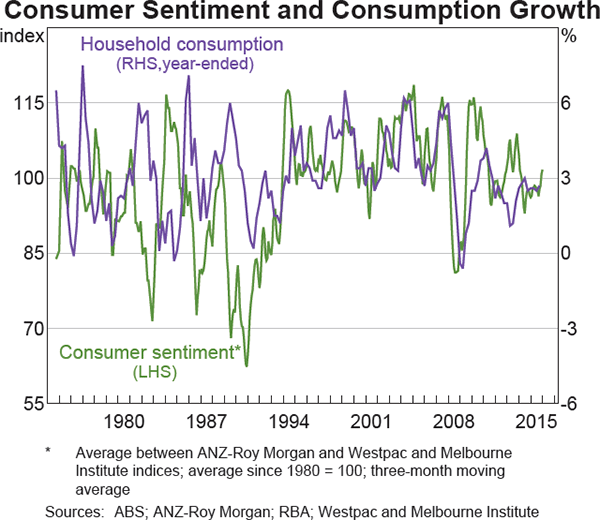
| Average of two consumer sentiment indices | |
|---|---|
| Consumption | 0.3 |
| Durable consumption(b) | 0.5 |
| Gross domestic income | 0.5 |
| Domestic final demand | 0.5 |
| GDP | 0.4 |
|
(a) Both sentiment indices are averaged over each quarter; correlations are calculated
from 1974 to 2015; growth in trend measures are used as growth in seasonally
adjusted measures are much more volatile Sources: ABS; ANZ-Roy Morgan; RBA; Westpac and Melbourne Institute |
|
However, the relationship between the headline consumer sentiment indices and these economic variables is unstable over time (Graph 3 and Graph 4).
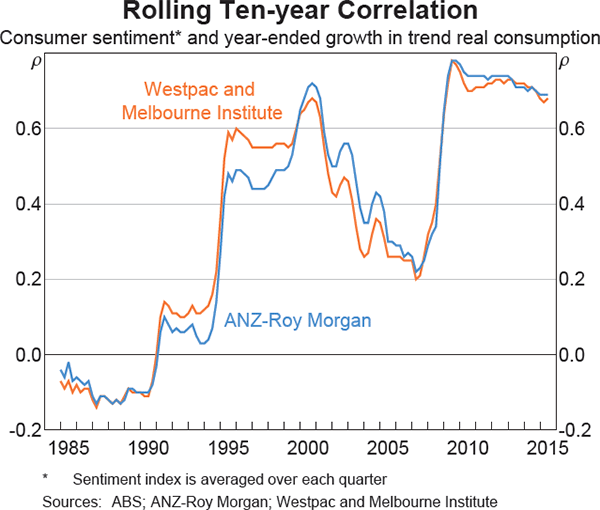
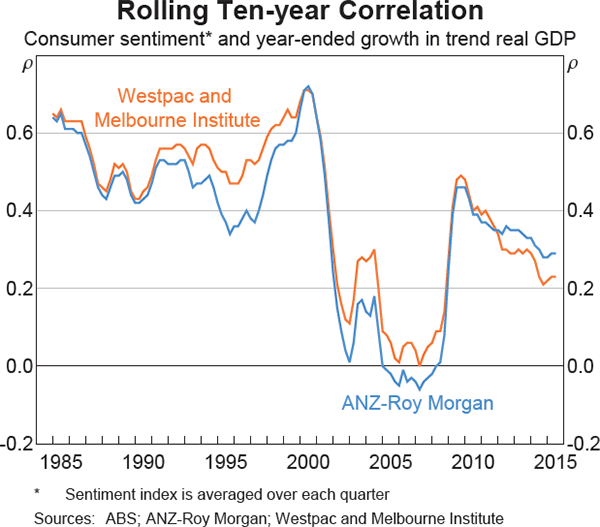
This is consistent with research from the Bank of England, which has found similar changes over time in the United Kingdom (Berry and Davey 2004). In Australia, at least, it appears that household sentiment is more highly correlated with other measures of economic conditions during major turning points, such as the global financial crisis, than during smaller fluctuations in conditions.
To examine these relationships more fully, we use regression techniques to test formally whether current and past values of consumer sentiment provide incremental information about selected economic variables beyond what past values of those economic variables contain.[5] Our preferred specification uses an average of the two headline sentiment indices in the regressions, since this is likely to be less noisy than each of the individual series by themselves. However, tests using the individual measures yield similar results.
The results suggest that the headline indices contain statistically significant incremental information for all selected economic variables (Table 3). There also appears to be evidence that consumer sentiment survey measures from the previous quarter contain information about current economic variables. Despite some of the questions asking about conditions one and five years ahead, longer lag structures performed less well.
| Contemporaneous sentiment term | One-quarter lag | |||
|---|---|---|---|---|
| Consumption growth | 0.15*** | (0.13**) | 0.15*** | (0.15**) |
| Durable consumption growth(b) | 0.44*** | (0.39***) | 0.41*** | (0.36**) |
| Gross domestic income growth | 0.29*** | (0.21***) | 0.29*** | (0.16*) |
| Domestic final demand growth | 0.28*** | (0.22***) | 0.31*** | (0.24***) |
| GDP growth | 0.20*** | (0.08) | 0.18*** | (0.02) |
|
(a) Sentiment series used is the average of the two headline indices; estimated from
1974 to 2015; ***, ** and * represent statistical significance at the
1, 5 and 10 per cent level, respectively Sources: ABS; ANZ-Roy Morgan; RBA; Westpac and Melbourne Institute |
||||
To assess whether the surveys contain incremental information apart from turning points, we run the same tests as above, but use dummy variables to exclude the recessions in the early 1980s, the 1990s and the global financial crisis period, which are major turning points in the sample. The results show that the surveys have been more useful around turning points, but they do still retain some incremental information once turning points are excluded from the sample.
Components of the headline index
The questions that make up the headline index all have a different focus and it is possible that some of them individually provide better information about economic activity than the headline index. To see if this is the case, we also examine the relationship between the surveys' component indices and the economic variables examined in the previous section using the same framework. The examination is restricted to the components of the Westpac and Melbourne Institute survey, as a sufficiently long time series of the ANZ-Roy Morgan components is unavailable.
The results show that the component tracking households' perceptions of their current personal finances compared with a year prior generally performs well in terms of statistical significance, even in the absence of turning points (Graph 5 and Table A1). In the tests assessing its relationship with growth of total and durable consumption, it actually performs better than the headline index. That said, even the personal finances component is not statistically significant in all possible specifications of the testing model, especially those that include all other components. The component tracking households' perceptions of their personal finances compared with what they expect a year ahead and the component tracking their perceptions of buying conditions for major household items are also particularly useful in predicting growth of durable consumption.[6] This is consistent with households planning their durable goods purchases.
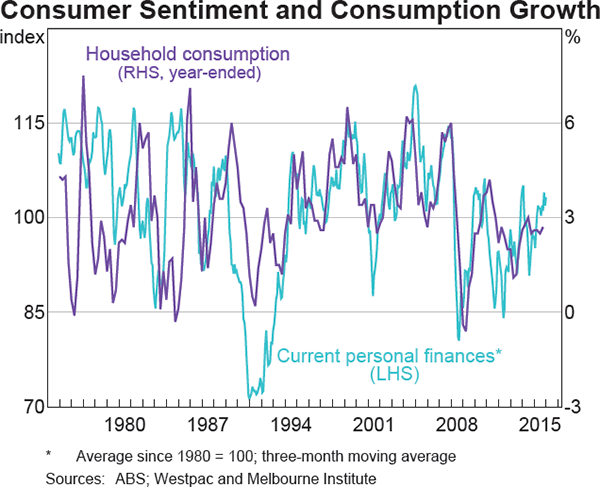
Is the Information Content Unique?
While the surveys generally contain useful information about economic activity, it may be that they are informative only because they summarise information contained in other available economic variables, rather than providing unique information. Previous studies have found that only movements in sentiment that summarise other available economic information have value for gauging developments in economic activity (e.g. Roberts and Simon 2001; Berry and Davey 2004; Wheeler 2010).
We explore whether this is true in the Australian data using a model based on the methodology in Berry and Davey (2004). We use the model to try to predict changes in the headline, personal finances and buying conditions sentiment series using other data that are publicly available before the sentiment surveys are conducted, including the cash rate, the unemployment rate and changes in share prices. We also use quarterly variables that are publicly available with a longer lag, such as wage growth, growth in housing wealth and GDP growth (for more details, see Appendix B).
We estimate how much of the variation in the sentiment series can be explained by these variables. The predicted values from the model capture the component of the sentiment series that summarises the other data. The residuals are the ‘unexplained’ component, which includes changes in sentiment that may or may not capture information relevant to gauging developments in economic activity. Because the unexplained component is constructed to be uncorrelated with the other already-released data, the information contained in this component can be thought of as unique to the consumer sentiment release. The sentiment measure we use in this modelling exercise is the average of the two headline consumer sentiment measures (although, again, the results are similar if either survey is used on its own).
As found in other studies, the explained components of the various sentiment series appear to have a close relationship with growth in total and durable household consumption, gross domestic income, domestic final demand and GDP (Table 4). The unexplained components are more volatile, but do exhibit a degree of correlation with household consumption growth. This is particularly apparent for the unexplained components of the sentiment series that track households' perceptions of their current personal finances compared with a year prior and their perceptions of buying conditions for major household items.
| Consumption | Durable consumption | Gross domestic income | Domestic final demand | GDP | |
|---|---|---|---|---|---|
| Explained component | |||||
| Headline index | 0.42 | 0.43 | 0.44 | 0.37 | 0.31 |
| Current personal finances | 0.42 | 0.38 | 0.35 | 0.21 | 0.11 |
| Buying conditions | 0.43 | 0.35 | 0.15 | 0.22 | 0.15 |
| Unexplained component | |||||
| Headline index | 0.28 | 0.21 | 0.12 | 0.22 | 0.09 |
| Current personal finances | 0.34 | 0.27 | −0.06 | 0.18 | 0.19 |
| Buying conditions | 0.24 | 0.10 | 0.04 | 0.16 | 0.15 |
|
(a) All sentiment indices are averaged over each quarter and decomposed using the model based on Berry and Davey (2004) Sources: ABS; ANZ-Roy Morgan; RBA; Westpac and Melbourne Institute |
|||||
We also use the decomposition of explained and unexplained sentiment in more formal testing. We augment the consumption growth models with all of the publicly available data used in the decomposition. For instance, we test whether the explained component of the headline sentiment index contains useful information for consumption, above and beyond what can be explained by publicly available outcomes for growth in consumption, GDP, housing wealth and wages in previous quarters, and the latest available outcomes for the unemployment rate, cash rate and share price growth preceding the survey period. In addition, we include contemporaneous and lagged terms of each unexplained component to avoid any omitted variable bias.
By construction, the explained components generally did not contain unique information. However, the unexplained portion of the component tracking households' perceptions of their current personal finances was found to contain some useful contemporaneous information for durable consumption. It also appears to be useful for explaining total consumption, although again this conclusion does not hold up in all possible specifications of the testing models. The unexplained portion of the component tracking households' perceptions of buying conditions for major household items is also found to contain some predictive information for durable consumption. Overall, the two measures do appear to be useful beyond just being a summary of other publicly available data. The unexplained portions of the other components were not found to contain useful information.
Conclusion
The two main consumer sentiment surveys in Australia are very similar in scope, construction and outcomes. They ask respondents about their personal finances, expectations for economic conditions and potential spending intentions. While the headline indices provide timely information about economic developments, the strength of their relationship with key macroeconomic variables varies across time. In particular, the survey measures of household sentiment seem to be more correlated with changes in broader measures of economic conditions during economic turning points.
Some of the components that make up the headline index seem to provide more information about specific economic variables than the headline index. This is true of the component that tracks households' perceptions of their current personal finances compared with a year prior, and the component tracking households' perceptions of buying conditions for major household items. Furthermore, these measures contain useful information that appears to be unique to the surveys, rather than just providing a summary of other publicly available data.
Appendix A
| Contemporaneous term | One-quarter lag | |||
|---|---|---|---|---|
| Current personal finances | ||||
| Consumption | 0.22*** | (0.23***) | 0.20* | (0.18***) |
| Durable consumption | 0.61*** | (0.60***) | 0.49* | (0.40***) |
| Future personal finances | ||||
| Consumption | 0.18** | (0.18***) | 0.12** | (0.21***) |
| Durable consumption | 0.63*** | (0.58***) | 0.63* | (0.56***) |
| Buying conditions | ||||
| Consumption | 0.12*** | (0.09*) | 0.13* | (0.10**) |
| Durable consumption | 0.29*** | (0.20*) | 0.35* | (0.30***) |
|
(a) Estimated from 1974 to 2015; ***, ** and * represent statistical significance at the 1, 5 and 10 per cent level, respectively Sources: ABS; RBA; Westpac and Melbourne Institute |
||||
Appendix B
Below is the model used to decompose consumer sentiment into its explained and unexplained components. Both models were estimated using OLS and, where required, monthly frequency data were extrapolated from quarterly frequency data using a cubic spline. The consumer sentiment series is a point-in-time observation, which coincides with the average between the first ANZ-Roy Morgan observation of each month and each monthly Westpac and Melbourne Institute observation. The lags of all variables on the right-hand side were chosen such that they only capture information that was available to respondents at the time the survey was conducted.
Model
Adjusted R2 = 0.65
Sample period: February 1990 to March 2015
Footnotes
The authors are from Domestic Markets and Economic Analysis Departments [*]
The Westpac and Melbourne Institute survey includes extra questions on a broader range of topics affecting households. On a monthly basis, respondents are asked about their unemployment expectations in a year's time, while on a quarterly basis they are asked about buying conditions for dwellings, the wisest places for their savings and their ability to recall certain news items. [1]
The Westpac and Melbourne Institute index is standardised so that its average since 1980 is equal to 100. Component indices for the ANZ-Roy Morgan survey are only available from 1996 so the headline measure is indexed to have the same mean as the standardised Westpac and Melbourne Institute index for consistency. [2]
Year-ended growth rates are presented as they are less volatile than quarterly growth rates. [3]
To match the quarterly frequency of the National Accounts, consumer sentiment indices are calculated as in-the-quarter averages. [4]
The t-tests are used to assess the significance of consumer sentiment in explaining
select economic variables. For example, the following model is estimated
for  where ΔGDPt−i is quarterly growth
in GDP and sentimentt−j is either
a contemporaneous (j=0) or lagged (j=1)
in-the-quarter average for the series that averages the ANZ-Roy Morgan and
the Westpac and Melbourne Institute headline sentiment indices. The t-test
is conducted on the estimated coefficient β. These simple
models explain less than one-third of the variation in selected economic
variables.
[5]
where ΔGDPt−i is quarterly growth
in GDP and sentimentt−j is either
a contemporaneous (j=0) or lagged (j=1)
in-the-quarter average for the series that averages the ANZ-Roy Morgan and
the Westpac and Melbourne Institute headline sentiment indices. The t-test
is conducted on the estimated coefficient β. These simple
models explain less than one-third of the variation in selected economic
variables.
[5]
Forecast evaluation showed that one-quarter-ahead forecasts were enhanced by taking into account consumer sentiment. [6]
References
Berry S and M Davey (2004), ‘How Should We Think about Consumer Sentiment?’, Bank of England Quarterly Bulletin Autumn, pp 282–290.
Roberts I and J Simon (2001), ‘What Do Sentiment Surveys Measure?’, RBA Research Discussion Paper No 2001-09.
Wheeler T (2010), ‘What Can We Learn from Surveys of Business Expectations?’, Bank of England Quarterly Bulletin, Q3, pp 190–198.
